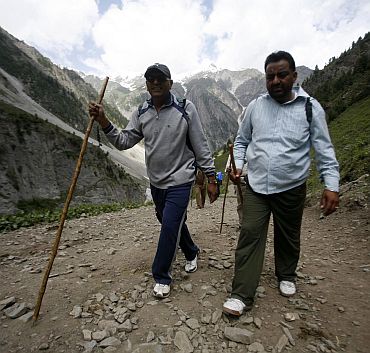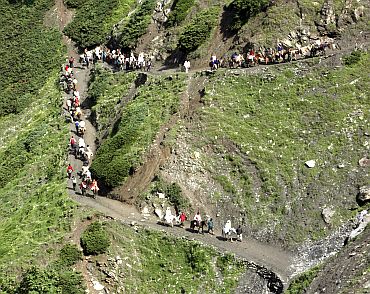 | « Back to article | Print this article |
Ice lingam inside Amarnath cave shrine melts!
The naturally formed ice lingam of Lord Shiva at the 3888-meter high Amarnath cave has melted.
"The holy ice lingam does not exist any more, as it melted totally on July 29", official sources said.
A record of four lakh pilgrims have in the meantime paid obeisance at the cave shrine in just a period of one month during the nearly two-month yatra to the holy cave shrine, they said.
According to a legend, Lord Shiva chose this cave to reveal to Goddess Parvati the secrets of life and death. Although the holy Amarnath cave is located in the Sindh valley besides Amarnath (Amravati) a small tributary of the Sindh River, it has been traditionally approached through the Lidar valley intersected by the Lidar nallah (riveulet).
On this route, the pilgrims approach the holy cave from Pahalgam in South Kashmir and cover around 46 km while passing through Chandanwari, Pissu Ghati, Seshnag and Panchantarni. Click on NEXT to read further...
Ice lingam inside Amarnath cave shrine melts!
Another shorter route is from Baltal, located on Srinagar-Leh highway. It is just around 15 km with some stretches, which rise and fall steeply. In the past, this route was used in early summers, but often it became impossible to use this route due to melting snow.
However, with passage of time, things have improved and movement on either of the routes has become comparatively easy.
Historians differ on the origin of Amarnath yatra. While some say it was there from historic times with a brief disruption, while others say it began with the discovery of the holy cave by Maliks or Muslim Shepherds in 18th or 19th century.
Historians are of the view that the Amarnath pilgrimage existed for thousands of years. Bringesha Samhita, Nilmat Puran, Kalhan's Rajtarangini etc, have references to this effect.
Ice lingam inside Amarnath cave shrine melts!
Bringesha Samhita narrates some of the important places where the pilgrims while going to Amarnath cave had to perform religious rituals. They included Anantnaya (Anantnag), Mach Bhawan (Mattan), Ganeshbal (Ganeshpora), Mamleshwar (Mamal), Chandanwari (2,811m), Shushram Nagar (Sheshnag) 3454m, Panjtarangeni (Panjturni) 3845m and Amravati.
Kalhan's Rajtarangini Tarang II has the legend of Kashmir ruler Samdimat (34 BC- 17 AD), who as a great devotee of Shiva 'used to worship linga of snow above the forests, which is not found anywhere in the world except during the delightful Kashmir summers'.
Kalhan has also mentioned that Sushram Naga (Sheshnag) is seen by pilgrims on way to Areshvara (Amarnath) to this day (ie, 1148-49 A.D). Nilmat Puran has reference to Amreshvara suggesting that the Shrine was known in 6th/7th century.
One of the greatest Muslim rulers of Kashmir, Zain-ul-abdin (1420-70 AD), fondly remembered by Kashmiris as 'Badshah', visited the Amarnath cave which has been documented by his chronicler Jonaraja.
Ice lingam inside Amarnath cave shrine melts!
Akbar's historian Abul-Fazal (16th century) in Ain-i-Akbari recorded, 'Amarnath is considered a shrine of great sanctity. When the new moon rises from her throne of rays, a bubble as it were of ice is formed in the cave, which daily increases little by little for 15 days till it is formed higher than two yards With waning of moon, likewise begins to decrease till no trace of it remains when the moon disappears.'
Vincent A smith, author of the Oxford History of India, while editing 2nd edition of Bernier's book, commented that the cave 'full of wonderful coagulations is the Amarnath cave where blocks of ice stalagmites formed by dripping water from the roof are worshipped by the Hindus, who resort here as images of Shiva'.
Vigne Bernier Montgomery in his book Travels in Kashmir, Ladakh and Iskardu (1842) says, 'The ceremony at the Amarnath cave takes place on 15th Sawan and not only Kashmir Hindus but also from Hindustan of every rank and cast 'can be seen travelling up the valley of Lidar towards the celebrated cave.'
Ice lingam inside Amarnath cave shrine melts!
Swami Vivekananda undertook the pilgrimage to Amarnath cave on August 8 in 1898 and later recounted, "I thought the 'ice lingam' was Shiva himself and there were no thievish Brahmins, no trade, nothing wrong. It was all worship. I have never seen anything so beautiful, so inspiring and enjoyed any religious place so much."
In his book Valley of Kashmir, Lawrence says that Brahmins from Mattan would join the Amarnath pilgrims and later at Batkut, Maliks would take charge, as they were responsible for maintaining the track, act as guide, carry the sick, old and ensure safety of life and belongings of pilgrims.
For this they received one-third of the offerings at the shrine. Brahmins of Mattan, Darmarth Trust (a religious body looking after various Hindu shrines in Jammu and Kashmir) and Giri Mahants of Amritsar, who carry the 'Chhari Mubarak' and are at the head of the main pilgrimage to this day since the advent of Sikh rule in Kashmir, receive the remaining share of offerings.
Ice lingam inside Amarnath cave shrine melts!
The historians supporting the historicity of Amarnath pilgrims say that the yatra may have been discontinued for a period for about 300 years from the middle of 14th century owing to turbulence following foreign invasions of Kashmir valley and migrations of Hindus from there.
Some historians say the cave was rediscovered in the summer of 1869 and the first formal pilgrimage to the holy cave was organized three years later in 1872 accompanied by the Maliks.
Despite militancy during the past two decades in Kashmir Valley, Amarnath yatra has been going on uninterrupted.
This year itself more than 1.7 lakh pilgrims had already visited the cave till the writing of this article.
This has been possible mainly due to the cooperation and support of local Muslims to the yatra.
Ice lingam inside Amarnath cave shrine melts!
Whatever the historians may have to say about the historicity of Amarnath Yatra, the fact is that it is not only a great bondage between the Hindu pilgrims and local Muslims who facilitate the yatra, but has also helped maintained a deep relationship in thought and aspiration between Kashmir and other parts of India that has existed for thousands of years.
Nationally revered Tamil poet Subramanya Bharathi was so much inspired by this bondage that he proclaimed Kashmir as the Crown of Mother India and Kanyakumari as lotus at her feet.






